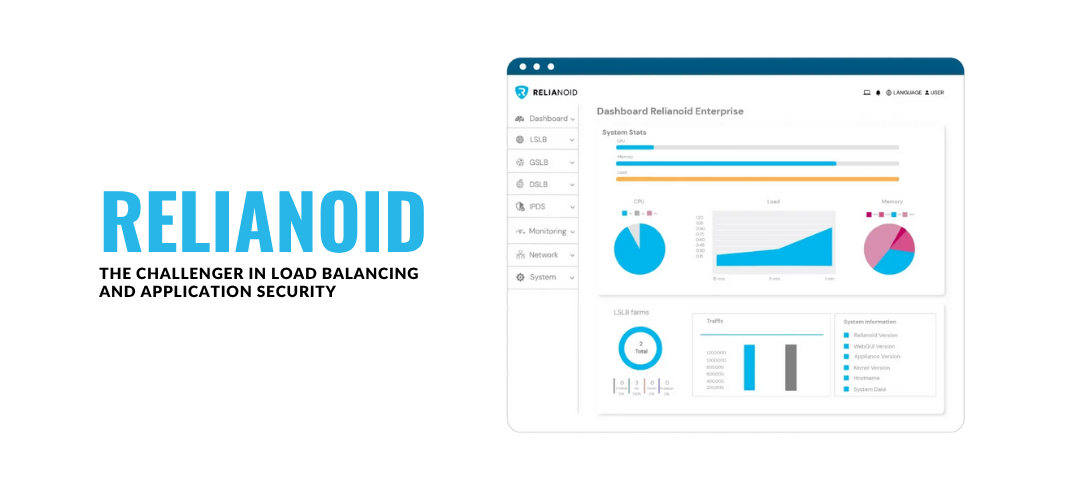In a technology landscape dominated by legacy giants and cloud-native disruptors, a fast-growing player is quietly making waves in the critical domain of load balancing and application security. RELIANOID is rapidly gaining recognition for delivering reliable, high-performance, and security-focused solutions tailored for modern IT infrastructures.
As organizations increasingly demand performance, availability, and security at every layer of their applications, the role of Application Delivery Controllers (ADCs) has become indispensable. RELIANOID’s flagship offering—a comprehensive, Linux-based load balancing platform—aims to meet these demands while offering flexibility, scalability, and affordability that appeals to both enterprises and service providers.
Built for High Availability and Performance
At its core, RELIANOID is an advanced reverse proxy and load balancer designed to distribute network traffic across multiple servers, ensuring uptime and optimal resource utilization. Its architecture supports Layer 4 (transport) and Layer 7 (application) load balancing, enabling users to fine-tune how requests are distributed based on protocol-level or content-level rules.
What makes RELIANOID stand out is its focus on high availability, a feature that many open-source solutions struggle to implement effectively. With features such as hot restart capabilities, connection draining, and real-time health checks, RELIANOID ensures that services remain uninterrupted, even during configuration changes or system updates.
An Emphasis on Application Security
In a digital world where application-layer attacks are more frequent and sophisticated than ever, security is not optional—it’s foundational. RELIANOID integrates application security features such as:
- SSL/TLS offloading
- Web Application Firewall (WAF) integration
- Rate limiting and DDoS mitigation techniques
- Mutual TLS (mTLS) for identity-based access control
Additionally, the platform supports real-time logging and integration with SIEM systems, enabling security teams to correlate data, detect anomalies, and respond to threats faster.
Designed for DevOps and Modern Infrastructure
RELIANOID fits naturally into today’s DevOps ecosystems. With REST APIs, JSON-based configurations, and support for Infrastructure as Code (IaC) practices, the platform can be fully automated and deployed using tools like Ansible, Terraform, or Kubernetes-native mechanisms.
Unlike many competitors that lock users into proprietary formats or management layers, RELIANOID provides full transparency and extensibility. It runs on standard Debian-based Linux systems and can be installed on bare-metal servers, virtual machines, or containers—whether in the cloud, on-prem, or in hybrid environments.
Competing with Giants Through Simplicity and Speed
The global load balancing market has long been ruled by traditional vendors such as F5, Citrix (now part of Cloud Software Group), and Kemp (now Progress). While these platforms offer mature and feature-rich solutions, they often come with high costs and steep learning curves.
RELIANOID is carving out its niche by offering a streamlined, cost-effective alternative without sacrificing performance or enterprise-grade features. Its open design and transparent licensing appeal particularly to managed service providers (MSPs), cloud-native startups, and enterprises seeking more control over their application delivery stack.
Moreover, RELIANOID provides both Open Source Community Edition and enterprise editions, with the latter including advanced modules, commercial support, and performance enhancements tailored for high-throughput use cases.
Use Cases: From SMBs to Telcos
The flexibility of RELIANOID has made it attractive across a diverse range of use cases:
- E-commerce platforms use it to ensure consistent performance during traffic spikes like Black Friday or product launches.
- SaaS providers use it to balance traffic across microservices, offload TLS, and secure API endpoints.
- Telecom operators rely on it to scale authentication services and route signaling traffic efficiently.
- Public institutions, banks, and universities deploy it to secure web applications and meet compliance requirements.
Because RELIANOID supports IPv6, HTTP/2, and modern cipher suites, it is future-ready and capable of handling cutting-edge network demands without expensive upgrades or replacements.
Strong Community and Documentation
One of RELIANOID’s key strengths is its developer-first approach. Its documentation is detailed and well-organized, and its Knowledge Base provides real-world examples, command-line cheatsheets, configuration templates, and troubleshooting guides. This makes onboarding much easier for system administrators and DevOps engineers who often work under pressure.
RELIANOID also maintains an active presence at major developer and cybersecurity conferences—such as Black Hat, DevOps events, and network engineering summits—both to engage with the technical community and to showcase innovations.
Recent Developments: HTTP/2, Hot Restart, and Beyond
The latests RELIANOID Enterprise Editions, introduce several key features that have made it even more competitive:
- HTTP/2 support: for faster web traffic handling, especially in mobile and latency-sensitive environments.
- High-performance proxy module: optimized for low-latency and high-throughput workloads.
- Hot restart: enabling administrators to reload configurations without dropping active connections.
- Improved observability: with enhanced metrics for Prometheus and integration options for Grafana dashboards.
With these additions, RELIANOID strengthens its position as a full-featured ADC capable of supporting mission-critical services in finance, telecom, healthcare, and digital infrastructure environments.
The Road Ahead
RELIANOID’s roadmap continues to evolve with a clear vision: deliver high-performance traffic management and security solutions that are accessible, transparent, and customizable. Upcoming features include native support for QUIC/HTTP/3, zero-trust network integrations, and AI-assisted traffic analytics for anomaly detection.
While still a challenger in a market dominated by billion-dollar incumbents, RELIANOID is proving that lean innovation, openness, and a developer-centric mindset can unlock real traction—especially in a world increasingly reliant on secure, reliable, and scalable digital services.
Final Thoughts
In today’s hyper-connected world, where milliseconds of latency and minutes of downtime can cost thousands of dollars, the need for a robust load balancing and application security solution has never been greater. RELIANOID offers a compelling alternative for companies looking for performance, security, and control—without vendor lock-in or licensing headaches.
As the adoption of multi-cloud and edge architectures continues to grow, platforms like RELIANOID that embrace automation, security by design, and cross-platform compatibility are well-positioned to thrive.
RELIANOID might just be the challenger quietly redefining how we think about load balancing in the modern era.

































